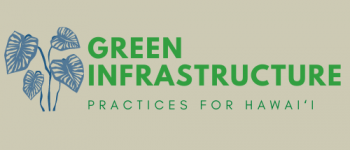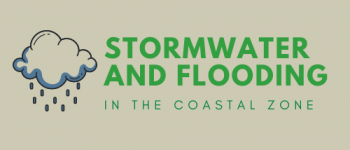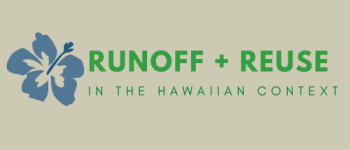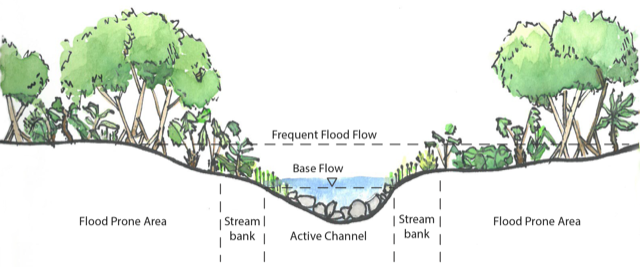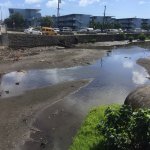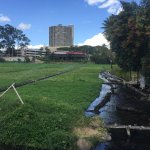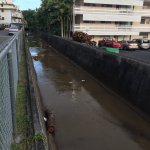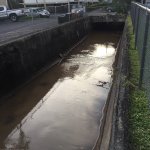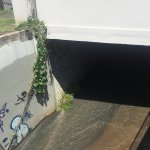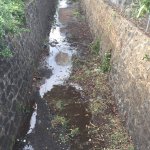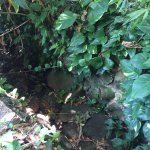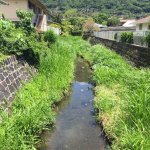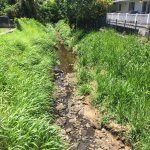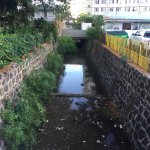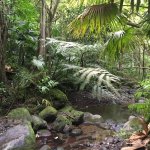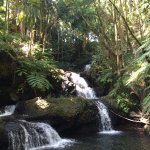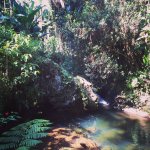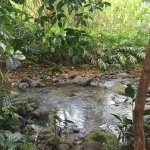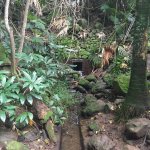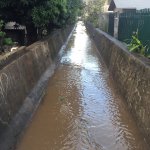The Streamside Guide: Recommendations for Hawaiʻi
Stream Stewardship Tips
Owners of land along waterways have the important responsibility to maintain areas of river and stream frontage on their properties. This guidance was created to encourage the application of best management practices for flood risk reduction, erosion control, ecosystem health, and water quality improvement on private properties throughout the Hawaiian archipelago.
This resource is applicable to all streamside properties, including agricultural, residential, and recreational uses in urban and rural areas of the state.

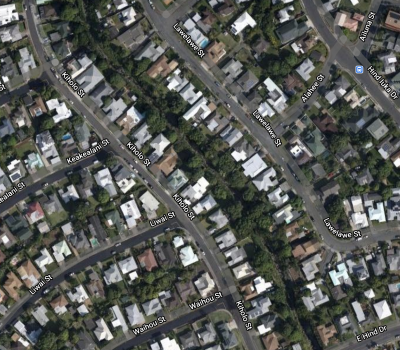

Routine Management Recommendations
-
Collect litter from the stream and stream banks and dispose of it with your household trash.
-
Remove large debris from the riparian zone. Tree trunks, low hanging branches, and other bulky items can ‘dam’ streams. During high-flow events, these dams force water over stream banks and can flood adjacent properties. Make sure large debris is moved well above the high water line so that it doesn’t get washed back into the stream during a flash flood (See FAQ’s to identify the high-water mark).
-
Prevent soil and debris runoff. Replace bare soil with vegetative cover or mulch.
-
Secure stream bank plantings. Make sure substrate is firmly patted down, otherwise plantings may be washed away when stream waters rise.
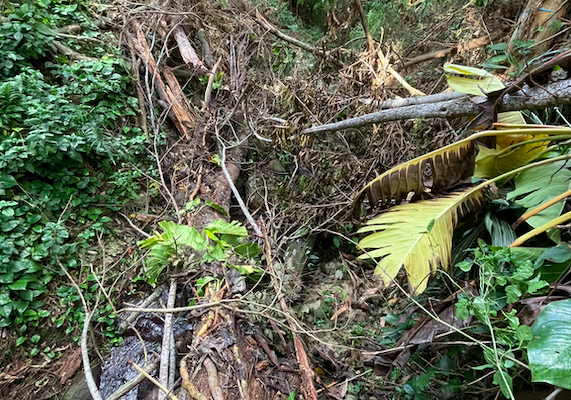

Benefits to Your Property
Responsible stream management is integral to riparian ecosystem health and it can also have great benefits at the individual property level.

Prevent Land Loss
Streambank stabilization is essential to prevent bank failure. Unlike most invasive species and turf grasses, stream-friendly species are deep rooted, holding substrate in place. They also provide habitat benefits, trap sediment, slow the flow of stormwater, and improve water quality. Never alter the stream channel or use branches or man-made materials to an attempt to stabilize the riparian zone.

Increase Property Value
Well-maintained streams can be an attractive asset that increases the value of your property. Stream issues like erosion and land loss may cause properties to lose value and increase exposure to natural hazards like flooding. Removing invasive brush and under-maintained shrubbery like dense hau bush (Hibiscus tiliaceu) can improve visibility around your stream, which may also have safety benefits.

Protect Your Health
Pollutants from households, urban roadways, and waste management systems can be washed by stormwater into streams, rivers, and the ocean without treatment and lead to human illness. To avoid sources of household contamination: pick up pet waste, wash cars on your lawn instead of in the road or your driveway, do not allow laundry outfalls or pools into drain into streams, avoid fertilizing prior to forecasted rain events, and upgrade cesspools to advanced methods of waste treatment.

Retain Your Topsoil
When water moves too quickly it is unable to infiltrate into the ground. Fast-moving water can cause scour, carrying soil and sediment off of your property and into waterways. The strategic consideration of slope, plants, and mulch can be used to slow stormwater velocity, allowing sediment to settle out of solution and water to infiltrate into the ground. An additional benefit to slowing the flow is that plants can absorb contaminants like nitrogen and heavy metals before they enter riparian ecosystems.
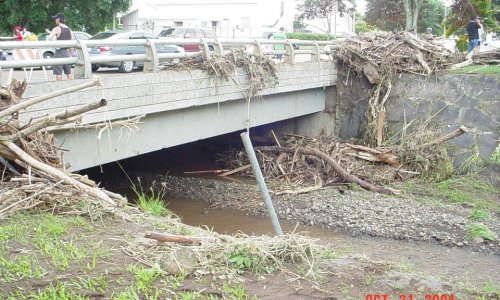
Mitigate Flood Risk
Flash floods commonly occur in Hawaiʻi’s steep watersheds. Flood waters can tear shallow-rooted plants and boulders from the streambank and collect tree trunks and debris as they move downstream. Debris jams can occur when the stream channel narrows, turns, or comes into contact with infrastructure like bridges. Debris jams force flood waters to flow up and over the stream bank and into the built environment. Such was the case when a destructive flooding event occurred at Mānoa Stream’s Woodlawn Bridge during a flash flood on October 30, 2004 that impacted the University of Hawaiʻi and Mānoa’s residential community.
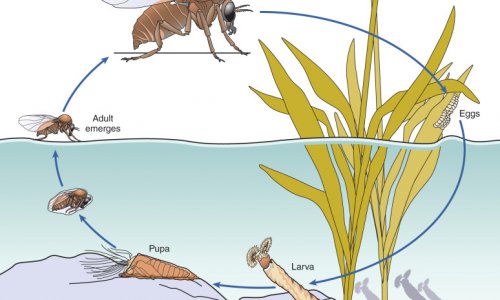
Eliminate Mosquito Habitat
Mosquitoes require still water to transition between their early life stages. Because mosquitoes can complete their development from egg to adult in less than a week it is important to avoid long periods of standing or sluggish water. Ditches and slow-moving streams can provide such habitat. Avoid the use of larvacides in yard areas and never use chemicals in the stream area. Remove debris like branches and leaves that cause water to pond and stagnate.
Stream-Friendly Yard Maintenance
Do not dump yard waste into the stream area.
Instead, collect branches, clippings, and leaves for curbside pickup or repurpose your waste into compost for your garden! Residents of the City & County of Honolulu can dispose of yard waste in their green bin. Larger properties and those located in areas with higher rainfall may qualify for a second or third green bin.
Consider leaving grass clippings on your lawn as you mow.
This low-maintenance gardening technique also frees up space in your green waste bin and when practiced over the course of a year is equivalent to one fertilizer treatment.
Actively maintain canopy trees so that they provide shade but do not block stream flow.
Shade is important to keep waters cool and mitigate the thermal impacts of stormwater runoff. However, canopy branches and limbs can fall into the stream area and cause flooding. Help to find the balance by keeping an eye on your canopy trees and clearing fallen vegetation as needed.
Use mulch for erosion control while plants become established.
Cover exposed soil to reduce sedimentation and runoff velocity. Consider covering mulched areas with a biodegradable erosion control fabric (well staked to prevent detachment) to keep mulch from floating away during periods of high water. Alternatively, cover the mulched areas with a single layer of stones to hold the mulch in place. Be sure and size the stones to be as large or larger than the ones in the adjacent stream bed. It’s not advisable to gather stones from the streambed to accomplish this as removal could potentially disrupt the natural streambed and promote erosion of the bed surface.
Remove weeds and invasive species before they become large and established.
If already established, avoid the use of herbicides. Seek stream-friendly alternatives like solarizing, steam, and removing the root ball or rhizome (see Common Invasive Species tab).

Remove and dispose of pet waste.
Animal feces that washes into streams can endanger human health as well as native fauna like the Hawaiian Monk Seal.
Do not fertilize riparian areas.
Native plants are adapted to low levels of nutrients and do not respond vigorously to fertilizers. Non-native invasive plant species on the other hand often respond quite well to fertilizers and applications encourage their growth, often at the expense of planted natives. For yards and properties near streams, use stream-friendly products (see Community Resources tab) and avoid fertilizing during the rainy season or prior to a forecasted rain event.
Reduce lawn area in favor of native trees, shrubs, and grasses.
Aim for a 50-foot vegetated buffer between your lawn and the steam. Deep roots will help to prevent streambank erosion, while simultaneously slowing down runoff and filtering pollutants.
Get to know your stream.
Make it a habit to observe your stream during periods of high water and take note of how flows effect bank conditions. This is particularly important if you have areas of troublesome erosion; the cause of which may not be readily apparent at low flows but can be easily viewed during high water.
Document erosion issues.
Consider how conditions along each bank guide water flow, paying particular attention to areas where velocity is highest and the turbulence the greatest. Debris may accumulate in and impact different areas depending on water level. Only through regular observations during a range of flows can conditions resulting in erosion be thoroughly understood. Having photos or short videos of these conditions will help when the causative condition for erosion on your bank is due to a situation on your neighbor’s property. Working together, informed by with observational documentation, solutions can be worked out.
Stream-Friendly Plants
Riparian buffers are a form of voluntary management that make a tremendous difference to stream health when applied across a watershed. The following ‘stream-friendly’ plants are recommended for use in the ‘riparian area’ which extends from the toe to the top of the stream bank.
Plants located closer to the stream channel prefer ‘wet feet’ and have a tolerance for periods of extended inundation. Deep-rooted species that prefer well-drained soils are appropriate for filling areas of exposed soil and stabilizing the middle of stream bank. Trees and shrubs are ideal for use in the upland zone where branches and debris will not fall into the channel or block stream flow.
Removal of invasive plants and planting of some of the suggested native riparian species is a lengthy process that doesn’t end with getting the new plants in the ground. It often first involves the removal of invasive species, planting and mulching new plants and then a period of maintenance where invasive plants are regularly weeded to foster the growth and establishment of the planted vegetation. On-going maintenance includes the occasional removal of accumulated debris hampering growth, pruning of establishment plants to prevent collection of flood-born floating debris and the occasional replanting of plants that do poorly or perish. Like any gardening effort, riparian re-vegetation requires regular attention to foster healthy conditions especially following periods of high water.
Hover over the species below to learn which are best suited to your streamside property’s needs.
Recommended Plants for the Riparian Zone
‘Ahu‘awa
‘Ahu‘awa
Scientific Name: Cyperus javanicus
Stream Benefits: Water quality, Erosion control
Status and Description: Indigenous gray-green sedge up to 3′ tall, leaf blades 3/4-1″ wide with razor-sharp margins
Habitat: Marshy areas, stream banks, coastlines
Medicinal and Cultural Uses: Yes, medicines and cordage
Sources and More Information: Bishop Museum
Makaloa
Makaloa
Scientific Name: Cyperus laevigatus
Stream Benefits: Water Quality, Erosion Control
Status and Description: Indigenous, 1-2.5′ high, 8′ spread
Habitat: Water-loving, grows in fresh water streams and along banks where substrate is saturated. Full to partial sun.
Medicinal and Cultural Uses: Yes, mats, clothing, cordage, medicine
Sources and More Information: Native Plants Hawaii
'Uki
‘Uki
Scientific Name: Cladium jamaicense
Stream Benefits: Water quality, Erosion Control
Status and Description: Indigenous, 2-6′ tall
Habitat: Marshes, ponds, along banks of streams
Medicinal and Cultural Uses: Yes, decorative elements
Sources and More Information: Native Plants Hawaii
Neke Fern
Neke Fern
Scientific Name: Cyclosorus interruptus
Stream Benefits: Erosion Control
Status and Description: Indigenous, 1-3′ high, spreading
Habitat: Water-loving, grows in wet marshy areas or on the margins of estuaries and streams
Medicinal and Cultural Uses: Yes, lei
Sources and More Information: Hui Ku Maoli Ola, Native Plants Hawaii
ʻAkaʻakai
ʻAkaʻakai
Scientific Name: Schoenoplectus tabernaemontani
Stream Benefits: Water Quality, Erosion Control
Status and Description: Indigenous, Grass-like, 2-6′ high, 8′ spread
Habitat: Water-loving, grows in fresh water and along banks where substrate is saturated
Medicinal and Cultural Uses: Yes, stomach ache ailment, mats, house thatching
Sources and More Information: Native Plants Hawaii
Kalo
Kalo
Scientific Name: Colocasia sp.
Stream Benefits: Water Quality Improvement
Status and Description: Polynesian introduction, up to 3′, heart-shaped leaves, edible corm
Habitat: Water-loving, grows in ponds and on the margins of streams
Medicinal and Cultural Uses: Yes, food, fever treatment, insect bites
Sources and More Information: Bishop Museum
Kaluhā
Kaluhā
Scientific Name: Bolboschoenus maritimus
Stream Benefits: Water Quality
Status and Description: Indigenous, 2.5′ tall
Habitat: Moist to very wet coastal sites, in fresh or brackish water up to 3 feet deep.
Medicinal and Cultural Uses: Unknown
Sources and More Information: Native Plants Hawaii
Kaʻa
Kaʻa
Scientific Name: Cyperus trachysanthos
Stream Benefits: Water quality
Status and Description: Endemic, 1-3′ tall
Habitat: Saturated substrate
Medicinal and Cultural Uses: Yes, haku, bathing
Sources and More Information: Native Plants Hawaii
Kohekohe
Kohekohe
Scientific Name: Eleocharis obtusa
Stream Benefits: Water Quality, Erosion Control
Status and Description: Indigenous, >1′ tall, 1′ spread
Habitat: Moist to very wet sites, can be grown with roots totally submerged in water
Medicinal and Cultural Uses: Yes, used to treat wounds and sores
Sources and More Information: Native Plants Hawaii
Kāwelu
Kāwelu
Scientific Name: Eragrostis variabilis
Stream Benefits: Water quality, Erosion Control, Weed Suppression
Status and Description: Endemic, clumping grass, drought tolerant, 1-2′ tall, 2-3′ spread
Habitat: Thrives in exposed, full sun, windy habitats
Medicinal and Cultural Uses: Yes
Sources and More Information: Maui Native Nursery Native Plants Hawaii
Carex
Carex
Scientific Name: Carex Sp.
Stream Benefits: Erosion Control
Status and Description: Endemic, 1-2′, grass-like
Habitat: Low water requirements, part to full sun
Medicinal and Cultural Uses: Unknown
Sources and More Information: Native Plants Hawaii
ʻAʻaliʻi
ʻAʻaliʻi
Scientific Name: Dodonaea viscosa
Stream Benefits: Erosion Control
Status and Description: Indigenous Shrub
Habitat: Tolerant of dry, windy, full sun areas
Medicinal and Cultural Uses: Yes, dye, fishing, lei, medicine
Sources and More Information: Native Plants Hawaii
ʻIlieʻe
ʻIlieʻe
Scientific Name: Plumbago zeylanica
Stream Benefits: Erosion Control
Status and Description: Indigenous, groundcover
Habitat: Well-drained soil, part to full sun
Medicinal and Cultural Uses: Yes, tattoos, medicine *roots of ʻilieʻe are toxic
Sources and More Information: Native Plants Hawaii
Vetiver Grass
Vetiver Grass
Scientific Name: Vetiveria zizanioides
Stream Benefits: Erosion Control, Water Quality
Status and Description: Introduced. Recommended by NCRS for use in Hawaii. Bunching, stiff grass with deep roots (up to 8′), 1-5′ high.
Habitat: Well drained soil, full sun, keep moist until established
Medicinal and Cultural Uses: Unknown
Sources and More Information: Natural Resources Conservation Service
Kokiʻo keʻokeʻo
Kokiʻo keʻokeʻo
Scientific Name: Hibiscus arnottianus
Stream Benefits: Erosion control, aesthetic beauty
Status and Description: Endemic, shrub or tree
Habitat: Well-drained soil, full sun, prefers moist conditions
Medicinal and Cultural Uses: Yes, lei
Sources and More Information: Native Plants Hawaii
Mamaki
Mamaki
Scientific Name: Pipturus albidus
Stream Benefits: Erosion Control
Status and Description: Endemic, shrub or tree 6-20′ tall
Habitat: Moist to wet forests
Medicinal and Cultural Uses: Yes, fiber, tea, medicine
Sources and More Information: Native Plants Hawaii
Naupaka kuahiwi
Naupaka kuahiwi
Scientific Name: Scaevola gaudichaudiana
Stream Benefits: Erosion Control
Status and Description: Endemic, shrub or tree, serrated leaves and white ‘half’ flowers
Habitat: Well drained soil, full sun, keep moist until established
Medicinal and Cultural Uses: Yes, lei, legends, and dyes
Sources and More Information: Native Plants Hawaii
Ti
Ti
Scientific Name: Cordyline fruticosa
Stream Benefits: Erosion Control
Status and Description: Polynesian introduction, 6-9′ tall, easily propagated through cuttings
Habitat: Well drained soil, part to full sun
Medicinal and Cultural Uses: Yes, thatch, offerings, medicine
Sources and More Information: Native Plants Hawaii
Species Status Meanings:
Endemic: Organisms native to Hawai‘i and not found naturally anywhere else in the world.
Indigenous: Organisms native to Hawai‘i and can be found naturally in other areas.
Introduced: Non-native organisms that were deliberately or accidentally brought to Hawai‘i by humans, including Polynesian Introductions.
Common Invasive and Nuisance Species
Invasive species can be intentionally or unintentionally introduced in places they are not native to and can quickly become established and spread uncontrolled throughout ecosystems. Invasive species have characteristics that make them difficult to compete with, including early maturity, rapid growth, effective seed dispersal, dense shade, allelopathy (chemical suppression of nearby plant growth), and lack of predators. These organisms compete with and displace native plants and animals, create monocultural stands that inhibit biodiversity, alter ecosystem functions and cycles, hybridize with native species, and enable the spread of new invaders.
The following list of invasive and nuisance species is not comprehensive but highlights some of the most pernicious species with direct impacts on Hawaiian streams.
Sources: CTAHR, Hawaii Invasive Species Council, University of Hawaii
Albizia
Scientific Name: Falcataria moluccana
Stream Impacts: Extremely rapid growth outcompetes undergrowth, sudden branch drop builds up debris in stream, ‘nitrogen-fixing’ impacts on soil enable other invasive species to take root
Status and Description: Member of the legume family, brittle/weak wood, grows up to 15 feet in a single year
Habitat: Open areas, disturbed areas, along waterways
Sources and More Information: Big Island Invasive Species Committee
Wedelia
Scientific Name: Falcataria moluccana
Stream Impacts: Forms a dense mat of vegetation, spreading horizontally and covering small shrubs and groundcover. Though effective at erosion prevention, this species should not be planted along riparian areas because of its aggressive nature.
Status and Description: Vigorous, creeping, herbaceous groundcover, 18-24″ high, yellow flowers
Habitat: Sun or shade, wide range of soil types and moisture tolerance
Sources and More Information: CTAHR
Feral Cats
Scientific Name: Felis catus
Stream Impacts: Predation of native fauna, contaminate freshwater with parasite Toxoplasma gondii in feces. Parasite threatens humans, Nēnē (Hawaiian goose; Branta sandvicensis), ‘Alala (Hawaiian crow; Corvus hawaiiensis), and Hawaiian monk seals (Monachus schauinslandi).
Status and Description: Small intelligent mammals, same species as the common domesticated cat
Habitat: Highly adaptive, widespread throughout the Hawaiian Islands
Sources and More Information: Hawaii Invasive Species Committee
Job's Tears
Scientific Name: Coix lacryma-jobi
Stream Impacts: Block the flow of waterways, gather debris in stream channels, outcompete native vegetation
Status and Description: Robust grass, grows forming dense and tall clumps, hard seeds
Habitat: Open areas, disturbed areas, along waterways
Sources and More Information: CABI
California Grass/Para Grass
Scientific Name: Brachiaria mutica or Urochloa mutica
Stream Impacts: Dominates freshwater riparian environments
Status and Description: Perennial, tall grass up to 6′ in height, mildly allelopathic.
Habitat: Riparian areas
Sources and More Information: University of Hawaii
Guinea Grass
Scientific Name: Urochloa maxima
Stream Impacts: Quickly grows in monocultural stands and outcompetes native vegetation
Status and Description: Perennial, tall clumping grass, blooms year-round, up to 6′ in height, widely tolerant of dry to very wet areas. Blooms year-round.
Habitat: Open areas, disturbed areas
Sources and More Information: Purdue
Kalihi Ginger
Scientific Name: Hedychium gardnerianum
Stream Impacts: Rapid spread, difficult to eradicate, reduces nitrogen, promotes erosion, inhibits stream flow, reduces light availability, forms dense monotypic stands, displaces native plants
Status and Description: Striking yellow flower spike, underground rhizome
Habitat: Open areas, disturbed areas, along waterways
Sources and More Information: USDA
Hau
Scientific Name: Hibiscus tiliaceus
Stream Impacts: When unmanaged, hau branches can droop down into the stream area and catch large debris during flooding events. These blockages can cause flooding and impede the migration of native species
Status and Description: Canoe plant, can be managed as a small shrub or grow into a large multi-trunked tree
Habitat: Commonly occurring along coasts, streams, and other wet areas to 300 m on most main islands
Sources and More Information: Bishop Museum
Suckermouth Catfish
Scientific Name: Hypostomus sp.
Stream Impacts: Digs into stream banks, causing erosion and siltation in streams. Outcompetes native stream fauna.
Status and Description: Armored scales, sail-like fins
Habitat: Rivers and streams
Sources and More Information: DLNR Aquatic Invasive Species
Umbrella Sedge/Ahuawa haole
Scientific Name: Cyperus involucratus or Cyperus alternifolius
Stream Impacts: Persistent stream-side weed. Disperses to new areas by water and in dumped garden waste
Status and Description:Perennial with upright stems occasionally reaching up to 1.5 m in height
Habitat: Open areas, disturbed areas, along waterways
Sources and More Information:Starr Environmental, Queensland Government
Red Mangrove
Scientific Name: Rhizophora mangle
Stream Impacts: Creates anoxic environments at stream mouths/brackish areas/esturaries, alters macrofaunal community structure, facilitates further invasion by exotic species. Seeds spread via water, allowing further streamside and coastal establishment.
Status and Description: Dense hard wood, arching prop roots, monocultural stands
Habitat: Rivers and streams
Sources and More Information: Environment Hawaii
Octopus Tree
Scientific Name: Schefflera actinophylla
Stream Impacts: ‘Strangles’ and kills host trees in its epiphytic form, shades out native vegetation, difficult to control once established
Status and Description: Perennial, fast-growing, shiny oval leaves, pink flower stalks
Habitat: Grows as a tree and as a parasitic epiphyte with aerial roots
Sources and More Information: Hawaiian Plants and Tropical Flowers, CTAHR
Legal Responsibilities
While the water that flows through streams belongs to everyone, portions of the riparian zone are often privately owned. When improperly managed, these areas can impact the health of our stream ecosystems and can cause downstream flooding and water quality impairment.
Hawaii Revised Statutes
[§46-11.5] Maintenance of channels, streambeds, streambanks, and drainageways.
Notwithstanding any law to the contrary, each county shall provide for the maintenance of channels, streambeds, streambanks, and drainageways, whether natural or artificial, including their exits to the ocean, in suitable condition to carry off storm waters; and for the removal from the channels, streambeds, streambanks, and drainageways and from the shores and beaches any debris which is likely to create an unsanitary condition or otherwise become a public nuisance; provided that to the extent any of the foregoing work is a private responsibility the responsibility may be enforced by the county in lieu of the work being done at county expense, and any private entity or person refusing to comply with any final order issued by the county shall be in violation of this chapter and be liable for a civil penalty not to exceed $500 for each day the violation continues; provided further that it shall be the responsibility of the county to maintain all channels, streambeds, streambanks, and drainageways unless such channels, streambeds, streambanks, and drainageways are privately owned or owned by the State, in which event such channels, streambeds, streambanks, and drainageways shall be maintained by their respective owners. [L 1986, c 121, §2]
Revised Ordinances of Honolulu
Article 26. Maintenance of Channels, Streambeds, Streambanks and Drainageways Sec. 41-26.3 Maintenance of streams.
The owner of any stream has the duty to maintain, dredge and clear such stream so that the natural flow of water runs unimpaired. The owner shall also be responsible for the removal of any debris, vegetation, silt or other items or material of any kind, that may interfere with the natural flow of water or is likely to create an unsanitary condition or otherwise become a public nuisance. (Added by Ord. 89-59; Am. Ord. 17-38)
Maui County Code
Homeowners have a responsibility to keep streams, gulches, waterways, and drainage swales under their individual ownership clear of debris.
B. No person, either directly or indirectly, shall block a drainageway on any public property without the prior approval of the department of public works of the county of Maui.
(Ord. 2490 § 1, 1996: Ord. 1816 § 1 (part), 1989)
12.12.040 – Violation—Penalty.
A. Any person who violates any provision of this chapter shall, upon conviction, be punished by a fine not exceeding five hundred dollars. B. The continuance of any such violation after conviction shall be deemed a new offense for each day of such continuance.
Am I a Stream Owner?
Different sections of the same stream can be owned by separate entities. Generally speaking, stream areas in the mauka portion of the watershed, lands zoned as Conservation, are owned and managed by the state. Further makai, it is often the county that owns and manages streams. The makai portions of streams are typically the most ecologically degraded due to upstream land use, polluted storm and wastewater runoff, concrete channelization, and the transition of vegetation from native to invasive species. State and county maintenance usually consists of removing debris such as fallen trees, trash, and accumulated sediment to keep waterways flowing and prevent floodwaters from overtopping the stream or river bank.
Between these two zones, a patchwork of private ownership spans our stream reaches. Large landowners, farms, private residences, schools, commercial sites, and trusts that own streamside parcels are responsible for keeping stream channels clear and maintaining their streambanks.
Determine if you are responsible for the maintenance of the stream bordering your property by reviewing your deed.
If needed, order a copy of your deed from the Department of Land and Natural Resources Bureau of Conveyances.
View your property information on a county map portal:
Native Stream Fauna
Hawaii’s native stream fauna are endemic, meaning that they evolved in situ with the Hawaiian Islands. As such, their survival depends on the conservation and restoration of the archipelago’s unique stream habitats. Native species threatened by urban development, 20-21st Century flood control structures and stream modifications, climate change, and management practices such as dredging.
Learn more about Hawaiian Stream Animals by exploring Nā Wai ‘Ekolu’s Storymap. Scroll your mouse below to get started:
Frequently Asked Questions
Do I need flood insurance?
Most streamside landowners will have at least a portion of their property in the Federal Emergency Management Agency National Flood Insurance Program floodzone. If you require a mortgage, it is necessary to purchase flood insurance. Even if you do not fall within a high-risk flood area, consider purchasing flood insurance to secure your assets and peace of mind. Outside of high-risk zones flood insurance is often very affordable. If you live in a county that participates in the Community Rating System you will receive a flood insurance discount.
Resources:
Department of Land and Natural Resources (DLNR) Engineering Division, National Flood Insurance Program
DLNR, Flood Hazard Assessment Tool
How do I mitigate runoff from my property into the stream?
There is a spectrum of ways to address stormwater runoff.
Low/No Cost:
- Sweep debris from your driveway instead of hosing it off.
- Wash your vehicle on your lawn instead of over pavement so that the soapy water does not make its way to a stormwater outfall and into the closest stream.
- Plant native plants between your home and the stream, creating a vegetative buffer for water to flow through before reaching the waterway. This buffer will slow down water, settling sediment out of solution and removing contaminants.
- Redirect stormwater to flow over grass or vegetation rather than pavement. This keeps water from heating up as it would from flowing over concrete/asphalt. Heated stormwater mixing into streams and rivers causes thermal changes that can negatively impact habitat, spawning, and migration patterns.
Mid-range options and Investments:
- Use of permeable pavers instead of traditional pavement. When it comes time to repave your driveway or you want to build a patio, consider green options that allow stormwater to filter into the ground instead of ‘running off’ downslope and into streams.
- Purchase or build a rain barrel. The use of a rain barrel does not filter water, but captures it for use on your property and reduces stormwater volume during rain events. Get a rebate for your investment!
- Build a rain garden. If you have a natural depression on your land, consider planting in this zone to create a rain garden! Rather than a nuisance, you can transform low spots that pool stormwater into beautiful amenities that hold rainwater for a period of hours or days, allowing it to seep into the ground while pollutants are filtered by stream-friendly plants.
For more ideas, check out Healthy Yards–>Clean Streams
How do I practice stewardship if I am physically unable to maintain the stream bank and my yard myself?
Everyone who practices responsible waste management is a stream steward, and there is plenty more you can do to help. Make sure that if you hire someone to help maintain your yard that they are using green bins to dispose of organic refuse and fertilizing responsibly. If a large tree or other debris is blocking your stream area, consult an arborist or tree maintenance service to have it removed professionally. If you hire a company to replace your driveway or patio, consider replacing paved areas on your land with vegetation or permeable pavers.
How do I reduce streambank erosion?
Streambank stablization can reduce land loss and sedimentation issues. If you are having erosion issues consider the state of your streambank. If the bank is vegetated by sod or invasive species, it is important to replant the bank with deep-rooted stream-friendly plants. However, this should be done gradually to avoid further land loss issues. Avoid the exposure of bare soil by covering newly planted areas with mulch while roots become established. Leave a 2-3′ vegetated buffer at the toe of the stream at all times. Never place fill in the stream or modify the channel in any way. If streambanks are especially steep or erosion is severe, contact an engineer or geologist.
How do I report a stream blockage?
If you live in the City and County of Honolulu, you can call the Department of Facility Maintenance Clean Stream Hotline: 808-768-7890 or contact the Roads Division: 808-768-3343
In the County of Maui, contact the Department of Public Works: 808-270-7845
In Kauai County, contact the Department of Pubic Works: 808-241-4992, Email: publicworks@kauai.gov
In Hawaii County, contact the Department of Pubic Works: 808-961-8321. If the stream is county maintained, the Highway Maintenance Division will clear the blockage. If the stream is located on private property, the Engineering Division may assess the issue.
Privately owned streams are the responsibility of their owners. If there is a blockage on your land that impairs stream flow you may be charged until the debris is removed.
I have a cat. How do I reduce impacts on stream health?
Whether feral or domesticated, cats can serve as hosts to the parasite Toxoplasma gondii. This parasite is a threat to endangered species incuding Nēnē (Hawaiian goose; Branta sandvicensis), ‘Alala (Hawaiian crow; Corvus hawaiiensis), and Hawaiian monk seals (Monachus schauinslandi), as well as human health. When cat feces washes into streams the parasite enters waterways and infects vulnerable organisms.
What you can do
- Spay and neuter pet cats.
- Keep cats indoors or safely contained.
- Microchip pet cats so that you may be reunited if the cats should become lost.
- Never abandon pet cats. If you are no longer able to care for your pet, please surrender the cat to a local animal shelter so that it has a chance of being adopted.
- Do not feed feral cats.
- On O‘ahu humane cat traps are available for loan from the Hawaiian Humane Society. Trapped cats can be brought to HHS for spay, neutering, vaccinations, and other health services. The HISC recommends spayed and neutered cats should then be brought home as indoor pets or offered for adoption, but not re-abandoned.
Source: Hawaii Invasive Species Council, 2021.
I have a dog. How do I reduce impacts on stream health?
Pet waste is high in nutrients and pathogens. When raw sewage washes into waterways it can alter stream habitats and creates a conduit for bacteria, viruses, and other organisms to infect humans and other animals. Tapeworm, roundworm, E. Coli, giardia, salmonella, and others can be transmitted via dog waste. Scoop your animal’s poop and flush or dispose of it with your weekly refuse.
Is my cesspool/septic system impacting the stream on my property?
While onsite, a licensed engineer can evaluate whether you have the appropriate conditions for an IWS. Any IWS that replaces a cesspool has a mandatory 50 foot setback from a stream (per HAR 11-62). If this standard cannot be met, specialized solutions and a permitting variance will be required for your site.
If you are interested in converting your cesspool, visit https://tinyurl.com/
Resources:
Is there a way to fertilize responsibly?
Yes! Being stream-friendly doesn’t have to mean forgoing fertilizing your yard. Best practices are to carefully consider when you fertilize (avoid the wet season or times before forecasted rain events), how much you fertilize (use just what is needed), where you fertilize (avoid paved areas and leave a 25 foot buffer from waterways), and what you use to fertilize (buy ocean-preferred products). Another option is to leave grass clippings on your lawn after mowing. Grass is high in nitrogen, so as they break down clippings will add nutrients to the soil.
Another way to reduce your reliance on chemical fertilizer is by composting. Yard waste such as grass clippings and leaves can be combined with kitchen green waste (e.g. coffee grounds, vegetable waste, and cardboard) to create a nutrient-rich soil additive. Composting can be accomplished in many creative ways and with minimal investment, including compost piles, do-it-yourself bins made from reclaimed wood, elevated compost tumblers, or, if you are short on space, indoor compost bins.
Resources:
EPA, Composting at Home
University of Minnesota Extension, What to do with Lawn Clippings
I've observed illegal dumping. What do I do?
Reporting illegal dumping to authorities. Avoid confrontation with illegal dumpers.
- City and County of Honolulu- Environmental Concern Line at (808) 768-3300, go to www.cleanwaterhonolulu.com, click on “Contact Us”
- City and County of Honolulu 311 App (Specify: Abandoned Property, Homeless Concerns, Illegal Dump Site) View Data Sets Free Download
- Statewide- Hawaii State Dept. of Health, Solid and Hazardous Waste Branch, (808) 586-4226 or Highways Complaint Line (808) 831-6714
Plants along the streambank are exotic or invasive. Should they be removed?
It depends! Ornamental exotic species may not pose a threat as long as they are kept under control. If species are aggressively spreading or self-recruiting (i.e. ‘popping up’ throughout your yard), consider removing them as they may be invasive.
If the stream bank is vegetated by invasive species, it is important to replant the bank with deep-rooted stream-friendly plants and weed frequently. However, replanting should be done gradually to avoid causing instability, erosion, and sedimentation of the waterway. Depending on the extent of the revegetation, best management practices like silt fencing may be needed. Bare soil should be covered with mulch while roots become established and groundcover spreads. Leave a 2-3′ vegetated buffer at the toe of the stream at all times. Never throw invasive species into the waterway as a means of disposal.
What is a high water line?
It is important to understand the characteristics of the waterway that abuts your property. High-water marks can help you to determine fluctuations in water level and the extent of recent flooding. This information can be used to inform future decision making. High-water marks come in various forms, including, but not limited to: scour, deposition, shelving, presence of litter and debris, matted or bent vegetation, changes in plant communities or soil character, water staining on structures or tree trunks, disturbed leaf litter, and seed lines (water-dispersed seed deposition).
Resources:
United States Geological Survey, A USGS Guide to Finding and Interpreting High-Water Marks (Video)
U.S. Army Corps of Engineers, Field Identification of Ordinary High Water Mark
What are best practices following a storm?
Following high water events it is recommended that you visit your stream area to determine if any maintenance is required. Take photos or videos of conditions to document issues over time. Pay special attention to areas of new erosion and collections of debris and complete appropriate removal/repair measures prior to the next flood event. Chronic maintenance issues following high waters should be more closely investigated to determine a solution that requires less frequent maintenance.
The Streamside Guide in Action
If you would like to connect community members with free stream stewardship education, host a training, and inspire positive change along streamsides, please reach out below!
Stay in Touch
Due to a web error our recent inquiries were received, but no return email addresses were recorded.
If you have a question about the Streamside Guide please email mlander@hawaii.edu for more information.
Trainings and Events
No trainings or events are currently scheduled.
Volunteer Opportunities:
Community Resources
Ask a Gardener, University of Hawai‘i at Mānoa College of Tropical Agriculture and Human Resources
Everyday Actions You Can Take to Malama Our Watersheds, Hawai‘i Association of Watershed Partnerships
Forested Rain Gardens, Smart Trees Pacific
Green Infrastructure for Homeowners, City and County of Honolulu et al.
Hawai‘i Watershed Guidance, Hawai‘i Office of Planning Coastal Zone Management Program
Hawai‘i Backyard Conservation, City and County of Honolulu et al.
Hawai‘i Native & Polynesian-introduced Plants for Urban Gardens, Arbor Day Hawai‘i
Hawaii Stream Animals, Iolani School and University of Hawai‘i at Mānoa
Healthy Yards–>Clean Streams: Sustainable Practices for Homeowners, City and County of Honolulu Storm Water Quality Division
Homeowner’s Clean Watershed Guide, Hui o Koʻolaupoko
Ocean-Preferred Products, West Maui Kumuwai
Pacific Island Trees, Cal Poly Urban and Community Forestry
Plant Pono, Coordinating Group on Alien Pest Species (CGAPS)
Plants to Control Stream Bank Erosion, Waimanalo Watershed Restoration Project
Rain Gardens to Filter Stormwater Runoff and Reduce Water Pollution, Coral Reef Alliance (CORAL)
Urban Garden Center, University of Hawai‘i University of Hawai‘i at Mānoa College of Tropical Agriculture and Human Resources
Weeds of Hawai‘i, University of Hawai‘i University of Hawai‘i at Mānoa College of Tropical Agriculture and Human Resources
Wastewater, State of Hawaii Department of Health Clean Water Branch
Wai: Wastewater Alternatives and Innovations – Educational Resources
Department of Commerce and Consumer Affairs
City and County of Honolulu Stormwater Quality Division
Report a potential flood problem:
City and County of Honolulu-Call the Clean Stream Hotline: (808) 768-7890
City and County of Honolulu 311 App (Specify: Clogged Catch Basin, Construction Runoff, Flooding, Stormwater Pollution, Stream Maintenance) View Data Sets Free Download
Report directly to the City and County of Honolulu Department of Facility Maintenance – Road Division for Catch Basin Repairs, Stream/Easement Cleaning, Storm Drain Cleaning: https://311.hnl.info
Report illegal dumping:
City and County of Honolulu- Environmental Concern Line at (808) 768-3300, go to www.cleanwaterhonolulu.com, click on “Contact Us”
City and County of Honolulu 311 App (Specify: Abandoned Property, Homeless Concerns, Illegal Dump Site) View Data Sets Free Download
Statewide- Hawai‘i State Dept. of Health, Solid and Hazardous Waste Branch, (808) 586-4226 or Highways Complaint Line (808) 831-6714
Maui
Maui County Landscape and Gardening Handbook, Department of Water Supply
City and County of Honolulu
Adopt-A-Stream, City and County of Honolulu Storm Water Quality Division
Stream Maintenance, City and County of Honolulu Department of Facility Maintenance
Xeriscape On Oahu, Honolulu Board of Water Supply
Kaua‘i
Oki, Delwyn and Brasher, Anne. Environmental Setting and the Effects of Natural and Human-Related Factors on Water Quality and Aquatic Biota, Oahu, Hawaii
Brasher, Anne and Wolff, Reuben. Contaminants in the Watershed: Implications for Hawaiian Stream Biota
United States Geological Survey, Surface Water in Hawaii
Please adhere to all relevant Federal, State, and County/City regulations relating to the care and management of riparian areas. The information contained in ‘The Streamside Guide’ is not a substitute for consultation with government agencies, laws, or permitting processes.


